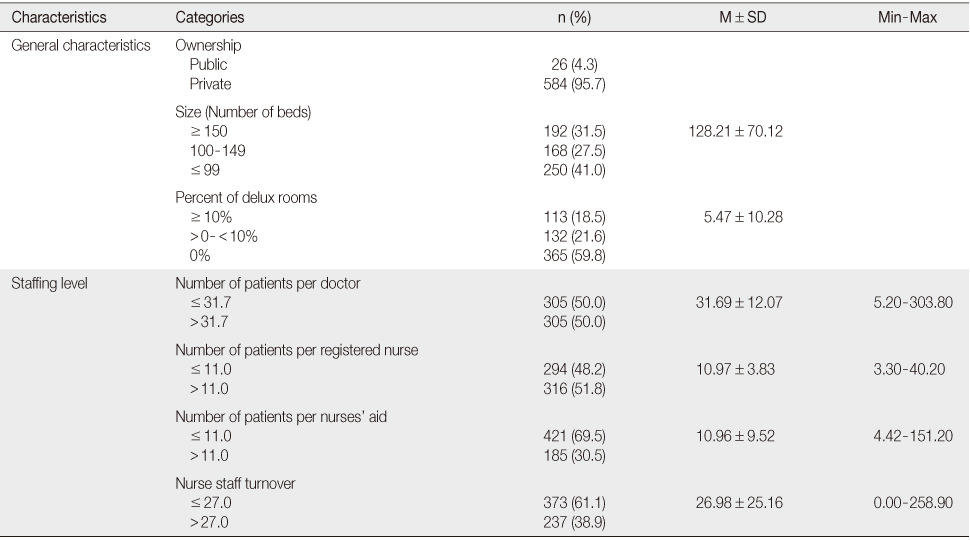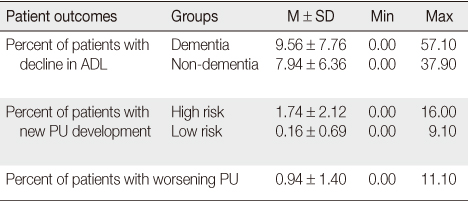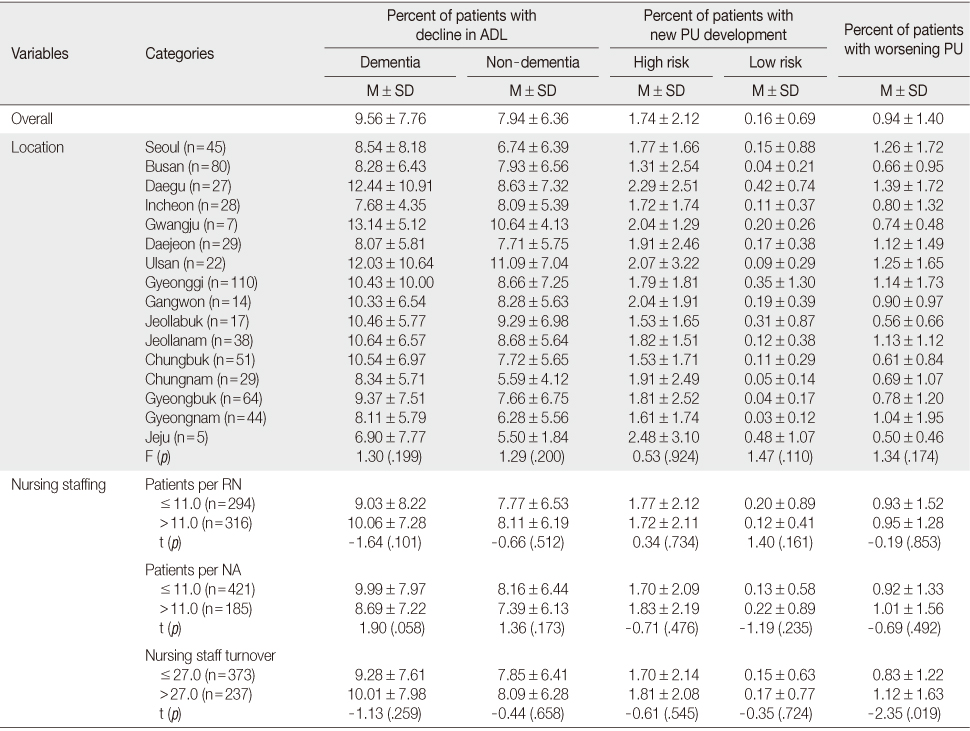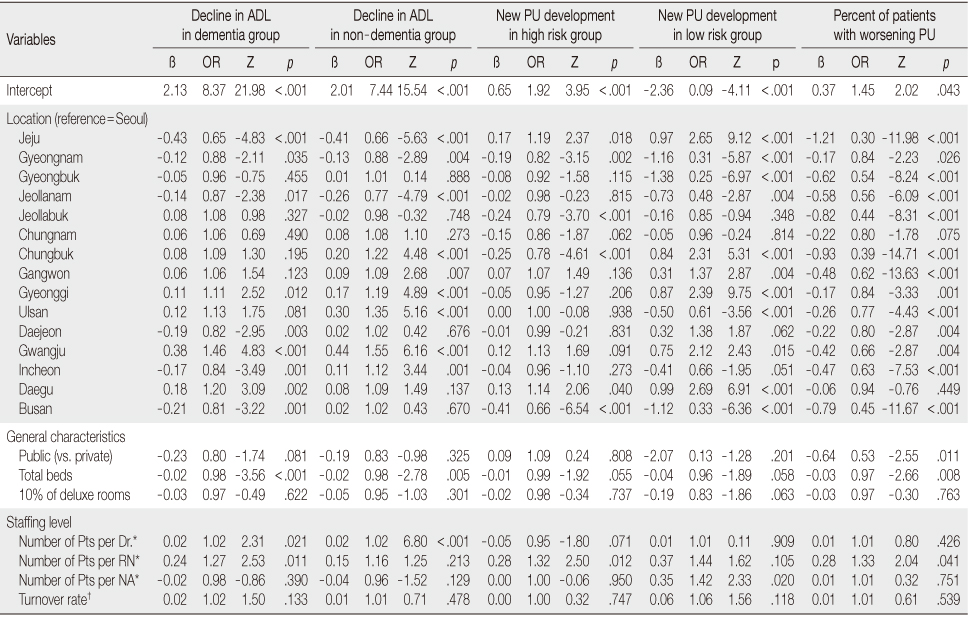Articles
- Page Path
- HOME > J Korean Acad Nurs > Volume 44(1); 2014 > Article
-
Original Article
- Impact of Nurse, Nurses' Aid Staffing and Turnover Rate on Inpatient Health Outcomes in Long Term Care Hospitals
- Yunmi Kim, Ji Yun Lee, Hyuncheol Kang
-
Journal of Korean Academy of Nursing 2014;44(1):21-30.
DOI: https://doi.org/10.4040/jkan.2014.44.1.21
Published online: February 28, 2014
1College of Nursing, Eulji University, Sungnam, Korea.
2Department of Nursing, Kangwon National University, Chuncheon, Korea.
3Department of Informational Statistics, Hoseo University, Asan, Korea.
- Address reprint requests to: Lee, Ji Yun. Department of Nursing, Kangwon National University, 1 Kangwondaehak-gil, Chuncheon 200-701, Korea. Tel: +82-33-250-8885, Fax: +82-33-242-8840, leejiyun@kangwon.ac.kr
© 2014 Korean Society of Nursing Science
This is an Open Access article distributed under the terms of the Creative Commons Attribution NoDerivs License. (http://creativecommons.org/licenses/by-nd/4.0/) If the original work is properly cited and retained without any modification or reproduction, it can be used and re-distributed in any format and medium.
Abstract
-
Purpose
- This study was conducted to explore the impact of registered nurse/nurses' aid (RN/NA) staffing and turnover rate on inpatient health outcomes in long term care hospitals.
-
Methods
- A secondary analysis was done of national data from the Health Insurance Review and Assessment Services including evaluation of long term care hospitals in October-December 2010 and hospital general characteristics in July-September 2010. Final analysis of data from 610 hospitals included RN/NA staffing, turnover rate of nursing staff and 5 patient health outcome indicators.
-
Results
- Finding showed that, when variables of organization and community level were controlled, patients per RN was a significant indicator of decline in ADL for patients with dementia, and new pressure ulcer development in the high risk group and worsening of pressure ulcers. Patients per NA was a significant indicator for new pressure ulcer development in the low risk group. Turnover rate was not significant for any variable.
-
Conclusion
- To maintain and improve patient health outcomes of ADL and pressure ulcers, policies should be developed to increase the staffing level of RN. Studies are also needed to examine causal relation of NA staffing level, RN staffing level and patient health outcomes with consideration of the details of nursing practice.
- 1. Song HJ, Chae JM, Park J. Development of payment for performance model according to evaluation of benefit adequacy of long term care hospitals. Seoul: Health Insurance Review & Assessment Service; 2013.05;Report No.: F88-2013-45.
- 2. Health Insurance Review & Assessment Service. Evaluation report of long term care hospitals in third year. Seoul: Health Insurance Review & Assessment Service; 2011.
- 3. Rantz MJ, Hicks L, Grando V, Petroski GF, Madsen RW, Mehr DR, et al. Nursing home quality, cost, staffing, and staff mix. Gerontologist. 2004;44(1):24–38.ArticlePubMed
- 4. Comondore VR, Devereaux PJ, Zhou Q, Stone SB, Busse JW, Ravindran NC, et al. Quality of care in for-profit and not-for-profit nursing homes: Systematic review and meta-analysis. BMJ. 2009;339:b2732. http://dx.doi.org/10.1136/bmj.b2732ArticlePubMedPMC
- 5. Spilsbury K, Hewitt C, Stirk L, Bowman C. The relationship between nurse staffing and quality of care in nursing homes: A systematic review. Int J Nurs Stud. 2011;48(6):732–750. http://dx.doi.org/10.1016/j.ijnurstu.2011.02.014ArticlePubMed
- 6. Castle NG, Anderson RA. Caregiver staffing in nursing homes and their influence on quality of care: Using dynamic panel estimation methods. Med Care. 2011;49(6):545–552. http://dx.doi.org/10.1097/MLR.0b013e31820fbca9PubMed
- 7. Bostick JE, Rantz MJ, Flesner MK, Riggs CJ. Systematic review of studies of staffing and quality in nursing homes. J Am Med Dir Assoc. 2006;7(6):366–376. http://dx.doi.org/10.1016/j.jamda.2006.01.024ArticlePubMed
- 8. Arling G, Kane RL, Mueller C, Bershadsky J, Degenholtz HB. Nursing effort and quality of care for nursing home residents. Gerontologist. 2007;47(5):672–682.ArticlePubMed
- 9. Zhang X, Grabowski DC. Nursing home staffing and quality under the nursing home reform act. Gerontologist. 2004;44(1):13–23.ArticlePubMed
- 10. Lee JY, Park EK, Yoon JY, Song SH. The current status of long-term care hospital. Seoul: Health Insurance Review & Assessment Service; 2007.12;Report No.: K42-2007-51.
- 11. Health Insurance Review & Assessment Service. Information of benefit criteria [Internet]. 2010;cited 2013 August 1. Available from: http://www.hira.or.kr/dummy.do?pgmid=HIRAA030010000000
- 12. Lee JY, Kim EY, Cho E. Factors impacting the physical function of older adults in Korean long-term care hospitals. J Korean Acad Nurs. 2011;41(6):780–787.ArticlePubMed
- 13. Yoon JY, Lee JY, Bowers BJ, Zimmerman DR. The impact of organizational factors on the urinary incontinence care quality in long-term care hospitals: A longitudinal correlational study. Int J Nurs Stud. 2012;49(12):1544–1551. http://dx.doi.org/10.1016/j.ijnurstu.2012.07.011ArticlePubMed
- 14. Lee SH. Multi-level analysis of factors related to quality of service in long-term care hospitals. J Korean Acad Nurs. 2009;39(3):409–421. http://dx.doi.org/10.4040/jkan.2009.39.3.409ArticlePubMed
- 15. Zinn JS, Weech RJ, Brannon D. Resource dependence and institutional elements in nursing home TQM adoption. Health Serv Res. 1998;33(2 Pt 1):261–273.PubMedPMC
- 16. Mukamel DB, Spector WD, Limcangco R, Wang Y, Feng Z, Mor V. The costs of turnover in nursing homes. Med Care. 2009;47(10):1039–1045. http://dx.doi.org/10.1097/MLR.0b013e3181a3cc62ArticlePubMedPMC
- 17. Katz MH. Multivariable analysis: A practical guide for clinicians. London, UK: Cambridge University Press; 2006.
- 18. Collier E, Harrington C. Staffing characteristics, turnover rates, and quality of resident care in nursing facilities. Res Gerontol Nurs. 2008;1(3):157–170. http://dx.doi.org/10.3928/00220124-20091301-03ArticlePubMed
- 19. Corazzini KN, Anderson RA, Rapp CG, Mueller C, McConnell ES, Lekan D. Delegation in long-term care: Scope of practice or job description? Online J Issues Nurs. 2010;15(2):Manuscript 4. http://dx.doi.org/10.3912/OJIN.Vol15No02Man04ArticlePubMedPMC
- 20. Flynn L, Liang Y, Dickson GL, Aiken LH. Effects of nursing practice environments on quality outcomes in nursing homes. J Am Geriatr Soc. 2010;58(12):2401–2406. http://dx.doi.org/10.1111/j.1532-5415.2010.03162.xArticlePubMedPMC
- 21. Zinn JS, Aaronson WE, Rosko MD. Variations in the outcomes of care provided in Pennsylvania nursing homes. Facility and environmental correlates. Med Care. 1993;31(6):475–487.PubMed
- 22. Castle NG. Nursing homes with persistent deficiency citations for physical restraint use. Med Care. 2002;40(10):868–878. http://dx.doi.org/10.1097/01.mlr.0000027357.74348.20ArticlePubMed
- 23. Harrington C, Swan JH. Nursing home staffing, turnover, and case mix. Med Care Res Rev. 2003;60(3):366–392. discussion 393-399. http://dx.doi.org/10.1177/1077558703254692ArticlePubMedPDF
- 24. Bostick JE. Relationship of nursing personnel and nursing home care quality. J Nurs Care Qual. 2004;19(2):130–136.ArticlePubMed
- 25. Hendrix TJ, Foreman SE. Optimal long-term care nurse-staffing levels. Nurs Econ. 2001;19(4):164–175.
- 26. Castle NG, Engberg J. Staff turnover and quality of care in nursing homes. Med Care. 2005;43(6):616–626.ArticlePubMed
REFERENCES
Figure & Data
REFERENCES
Citations

- The Experience of turnover to long-term care hospital nurse: A phenomenological qualitative research
Inhee Choo, Milim Cho, Eunha Kim
Journal of Korean Gerontological Nursing.2024; 26(4): 392. CrossRef - Physical Therapy Provider Continuity Predicts Functional Improvements in Inpatient Rehabilitation
Mitchell D. Adam, Debra K. Ness, John H. Hollman
Journal of Neurologic Physical Therapy.2023; 47(2): 91. CrossRef - The effect of the reformed nurse staffing policy on employment of nurses in Korea
Jinhyun Kim, Sungjae Kim, Eunhee Lee, Hyunjeong Kwon, Jayon Lee, Hyunji Bae
Nursing Open.2021; 8(5): 2850. CrossRef - Nurses’ Clinical Work Experience during Pregnancy
Hyunjung Lee, Hyoung Eun Chang, Jiyeon Ha
Healthcare.2020; 9(1): 16. CrossRef - Exploring Nurses' Perceptions of Nursing Home Care in South Korea: A Qualitative Study
Eunhee Cho, Hyejin Kim, Soo Jung Chang, Hyang Kim, Jeongah Kim
Journal of Korean Gerontological Nursing.2020; 22(2): 85. CrossRef - The Effects of Long-term Care Hospitals' Nurse Staffing Level on Patient Outcomes: Differences according to Region
Kyung Jin Hong
Journal of Korean Academy of Nursing Administration.2020; 26(4): 354. CrossRef - A Comparative Study on the Job Stress, Burnout and Nursing Performance of Nurses in Comprehensive Nursing Care Service Wards and Nurses in General Wards
Youn Sil Kim, Jung Ae Park, Eun Koung Seo
Stress.2019; 27(1): 46. CrossRef - Experiences of Long-term Care Hospital Nurses Caring for Elders with Dementia
Eun Kyoung Suh, Hye Ryoung Kim
Journal of Korean Gerontological Nursing.2019; 21(2): 99. CrossRef - Longitudinal associations of nursing staff turnover with patient outcomes in long-term care hospitals in Korea
Yoonseo Kim, Kihye Han
Journal of Nursing Management.2018; 26(5): 518. CrossRef - Influence of Nurses' Work Environment, Organizational Commitment, and Nursing Professionalism on Turnover Intention of Nurses in Long Term Care Hospitals
Hyun Suk Joo, Won Hee Jun
Journal of Korean Academy of Nursing Administration.2018; 24(4): 265. CrossRef - Importance, Performance and Rates of Nurse Performance of Nursing Interventions in Long-term Care Hospitals
Sunmi Kim, Seok Hee Jeong, Myung Ha Lee, Hyun Kyung Kim
Journal of Korean Academy of Nursing Administration.2017; 23(4): 359. CrossRef - Comparative Analysis Research of Inpatient Satisfaction with Nursing on Comprehensive Nursing Service Units & General Units and Nurses' Work Stress
Su Mi Jung, Sook Hee Yoon
Journal of Korean Academy of Nursing Administration.2017; 23(3): 229. CrossRef - Delegation of Nursing Activities in Long-term Care Hospitals
Eun Ju Jang, Su Hyun Kim
Journal of Korean Gerontological Nursing.2017; 19(2): 101. CrossRef - Effects of Empathy and Attitude in Caring for Elders by Nurses in Geriatric Nursing Practice in Long-term Care Hospitals
Young Kyoung Kim, Suhye Kwon
Journal of Korean Gerontological Nursing.2017; 19(3): 203. CrossRef - Predictors of Turnover among New Nurses using Multilevel Survival Analysis
Suhee Kim, Kyongeun Lee
Journal of Korean Academy of Nursing.2016; 46(5): 733. CrossRef - Factors Influencing Nurse Turnover Intention of Senior Convalescence Hospitals in the Metropolitan Area
Youn Sun Hwang, Eunyoung Cho
Korean Journal of Occupational Health Nursing.2016; 25(3): 156. CrossRef - Nursing outcomes of inpatient on level of nursing staffing in long term care hospitals
Eun Hee Kim, Eunjoo Lee
Journal of the Korean Data and Information Science Society.2015; 26(3): 715. CrossRef - The Effects of Emotional Labor and Job Involvement on Turnover Intention of Nurses in Long-term Care Hospitals
Su-Jeong Kang, Suhye Kwon
Korean Journal of Occupational Health Nursing.2015; 24(4): 290. CrossRef
Hospital Characteristics (N=610)
Patient Outcomes from Long Term Care Hospitals (N=610)
ADL=Activities of daily living; PU=Pressure ulcer.
Difference in Patient Outcome by Location and Nursing Staffing Level (N=610)
ADL=Activities of daily living; PU=Pressure ulcer; RN=Registered nurse; NA=Nurses' aid.
Impact of Nursing Staffing Level on Patient Outcomes in Long Term Care Hospitals (N=610)
*1 unit=10 pts; †1 unit=10%; ADL=Activities of daily living, PU=Pressure ulcer, Pts=Patients, Dr.=Doctor, RN=Registered nurse, NA=Nurses' aid, OR=Odds ratio.
ADL=Activities of daily living; PU=Pressure ulcer.
ADL=Activities of daily living; PU=Pressure ulcer; RN=Registered nurse; NA=Nurses' aid.
*1 unit=10 pts; †1 unit=10%; ADL=Activities of daily living, PU=Pressure ulcer, Pts=Patients, Dr.=Doctor, RN=Registered nurse, NA=Nurses' aid, OR=Odds ratio.
 KSNS
KSNS
 E-SUBMISSION
E-SUBMISSION




 Cite
Cite

